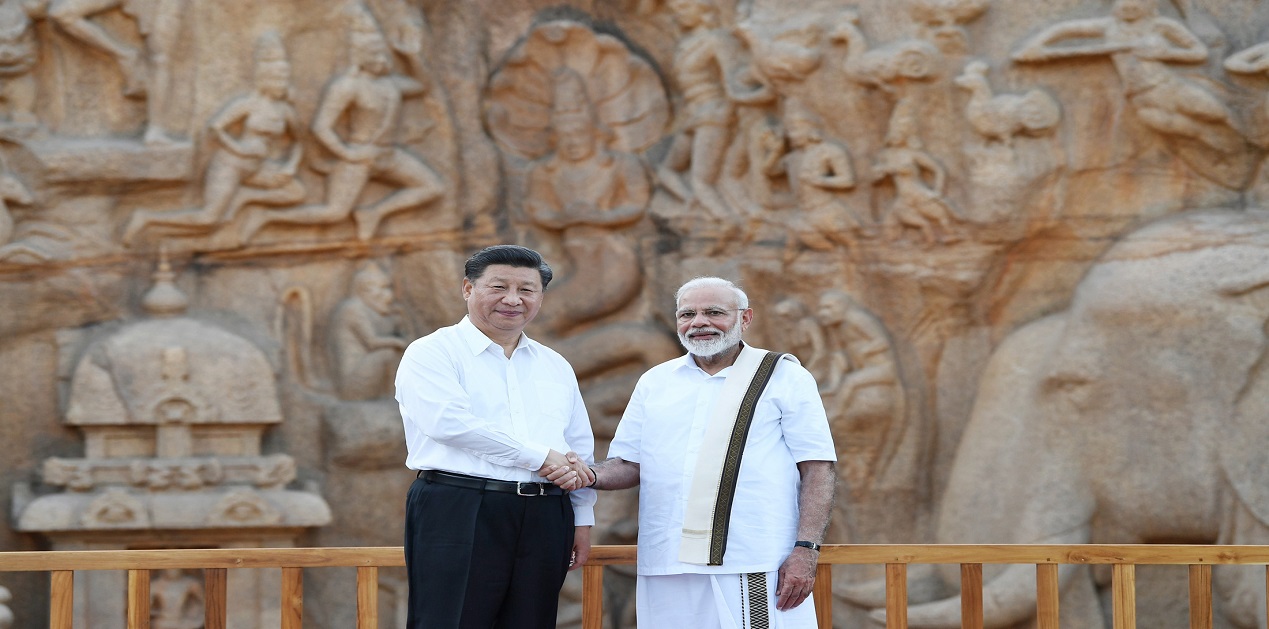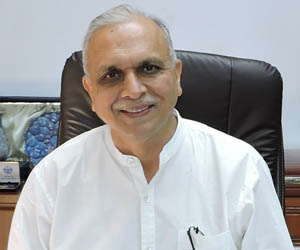The optics of the second Sino-Indian informal summit held at the UN Educational, Scientific and Cultural Organisation (UNESCO) World Heritage site Mamallapuram in Tamil Nadu was great. Chinese President Xi was given a warm welcome by Prime Minister Modi and taken on a tour of the stunning rock cut 7th century shore temples of Mamallapuram, depicting the scenes from the Mahabharat. Modi also presented President Xi a Kanjeevaram silk cloth bearing Xi’s portrait. President Xi said that he was ‘overwhelmed’ by the warmth and hospitality of the host.
Prime Minister Modi described the second informal summit as a continuation of the Wuhan spirit, a reference to the first informal summit that was held in Wuhan, China in April 2018. He said that the Mamallapuram summit will take forward the momentum in Sino-Indian relations which was built after Wuhan meeting. In his characterstic manner, Modi coined the phrase "Chennai connect" to describe the start of a ‘new chapter’ in Sino-Indian relation after the second informal summit.
Holding informal summits at beautiful locations is an innovation in Sino-Indian relations. A lot of goodwill is generated when two leaders meet in informal settings two discuss complex issues without any prior agenda. Without going into the nitty-gritty of complex matters, the leaders are able to an overview of the relationship and provide guidance to the officials about future directions. Such summits undoubtedly lower the temperature.
In the weeks preceding the summit, the relationship had been stressed particularly after India abrogated Article 370 of its Constitution. The Chinese took strong exception and described the Indian action as undermining China’s sovereignty. They helped organise an informal closed-door meeting at the UN Security Council on Pakistan’s request to discuss the India’s Kashmir action. They issued strongly worded statements on Kashmir echoing the positions taken by their all-weather friend Pakistan. Prime Minister Modi in his UN General Assembly (UNGA) address avoided any mention of Kashmir but the Indian foreign ministry issued appropriately worded statements countering China’s positions on Kashmir. The Indian External Affairs Minister, during his visit to Beijing in August, clarified the Indian position and sought to reassure the Chinese side that the Indian action did not mean any change in India’s position on the boundary question. That did not prevent the Chinese from making references to the UN Security Council resolutions in their statements as well as in the Sino- Pakistan joint press release issued on the conclusion of Pakistan Prime Minister Khan’s visit to Beijing a few days before the Mamallapuram summit.
An excellent ambience was created at Mamallapuram that must have helped in calming the situation that threatened to go out of control on account of Kashmir related statements. But, what did the summit achieve in terms in relation to the outstanding problems?
The Indian Foreign Secretary, in his press conference, summed up the results of the summit. He identified six main areas which the two leaders discussed: trade, people-to-people connect, tourism, defence and security, climate change, terrorism and the threat of radicalisation. He noted that the two sides had managed to avoid any disruptions in the bilateral relationship and take it forward.
Trade was perhaps the most important issue discussed at the summit. The major takeaway from the summit was that the two sides have agreed to set up yet another mechanism, this time at the levels of the finance ministers, to look at trade and investments issues in a holistic fashion. It will be recalled that India and China already have a strategic economic dialogue at the level of Niti Ayog and National Development Council of China to look into these matters. The ambit of discussions will be widened in the new mechanism that has been announced.
Significantly, Kashmir was neither raised not discussed. This was a wise move. Discussing Kashmir would have only accentuated the differences and derailed the summit.
On the boundary question, it was agreed that the Special Representatives will continue with their discussions. Nothing more. Clearly this is one of those intractable issues on which the two sides do not have a common view on its resolution.
No new confidence building measures to maintain peace and integrity of the border were announced. It was however, decided that the Indian Defence Minister will visit China in due course. The nitty-gritty of border management, joint military exercises et cetera will most likely be discussed during that visit.
The Mamallapuram summit should be assessed not just for what it achieved on the hard issues but also for highlighting the soft tissues. People may not remember the details of the discussions at Mamallapuram but they will not forget the stunning visuals of the shore temples of Mamallapuram.
It is becoming increasingly clear that the importance of soft power in India’s diplomacy is growing by the day. Prime Minister Modi has been at the forefront of showing India’s culture and civilisation to the visiting leaders. The Mamallapuram summit was all about India showcasing its considerable soft power. Mamallapuram, a UNESCO World Heritage, brings into relief the ancient China-India civilisational contacts dating back to several centuries. The Pallava Kings who ruled Mamallapuram circa the seventh-eighth centuries used to have trade connections with what is now the Fujian province of China. Archaeological findings show that Tamil traders had possibly built a temple there. The summit has evoked a great deal of interest in researching and documenting ancient civilisational contacts between India’s southern states and China.
Notwithstanding the hard problems of Sino-Indian relations, people-to-people contacts are becoming an important factor in bilateral relations. Mamallapuram summit will help the two sides to bring the public into the Sino-Indian relations in a big way. A series of activities leading up to the 70th anniversary of diplomatic relations next year are lined up to make Indian and Chinese public more aware of their historical relations. The two sides also seem to have discussed how to exploit the enormous tourism potential. That will yield a lot of economic benefit also.
Clearly, neither side came to the summit with the expectation of any major breakthroughs. None was achieved. It was merely decided that the discussions will continue at various levels to maintain the momentum in bilateral ties generated after the Wuhan summit.
The informal summit process which began at Wuhan to contain the fall out of the Doklam crisis will continue in future as well. Prime Minister Modi has been invited to visit China for the next informal summit. But there is also a risk that frequent informal summits may undermine the formal negotiating channels which are indispensable for any bilateral relationship to go forward.
The massive churn in the global environment impacts both countries deeply. They are competing with each other for their place in the world. Just as India is watching China’s moves such as the China Pakistan Economic Corridor and its growing influence in the neighborhood and the Chinese inroads into the Indian Ocean, China is also observing with some concern the growing closeness between India and the United States. India has upgraded its participation in the quadrilateral group of countries (QUAD) which will unnerve China. The two countries also have a separate channel of interaction on the multilateral fora such as Shanghai Cooperation Organisation, Russia-India-China trilateral, BRICS and G-20. India is also negotiating with China and other countries a giant free trade agreement Regional Comprehensive Economic Partnership (RCEP) agreement. If concluded, RCEP will tantamount to a free trade agreement between India and China.
The China-India relationship has become multidimensional. Although the core issues between the two countries remain, other issues are also gaining importance. Both sides need to approach the relationship with extreme caution and care. The two leaders, already having met 18 times since 2014, are interested in enhancing mutual understanding of these changes. They do not want the bilateral relationship to be derailed by the difficult issues. As Mr Modi observed at the delegation level talks, Mamallapuram summit is a step towards ‘managing’ the relationship and building trust and not letting differences become disputes.
Neither side seems to be in a mood to take up the difficult questions at this stage to avoid derailing the relationship. That seems to be the message coming from Mamallapuram. The difficult issues like the boundary question can await resolution. The second informal summit kept the focus on convergences with an eye on the future. The emphasis in Mamallapuram seems to have been to ‘manage’ the differences ‘prudently’.
(The paper is the author’s individual scholastic articulation. The author certifies that the article/paper is original in content, unpublished and it has not been submitted for publication/web upload elsewhere, and that the facts and figures quoted are duly referenced, as needed, and are believed to be correct). (The paper does not necessarily represent the organisational stance... More >>
Image Source: https://www.pmindia.gov.in/wp-content/uploads/2019/10/H2019101178117.jpg










Post new comment